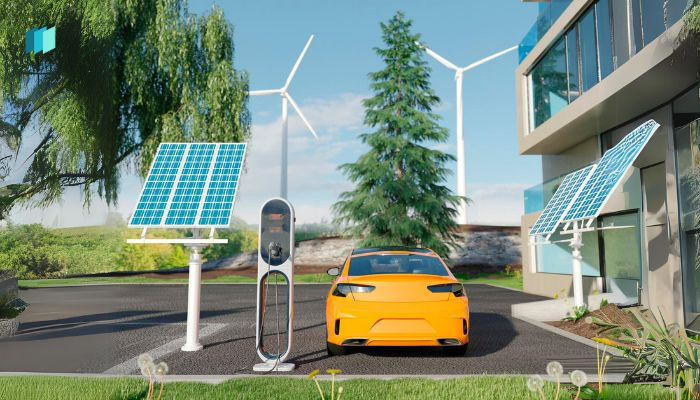In recent years, the quest for sustainable mobility has taken a giant leap forward with the advent of solar-powered EV charging stations. Imagine a city where electric vehicles (EVs) juice up with clean solar energy, dramatically reducing urban carbon footprints and transforming cityscapes worldwide. According to Bloomberg Green, solar-powered charging stations are set to grow by over 20% annually, signaling a green revolution in urban transportation. In this article, we delve into how these innovative stations are changing the face of cities, offering a sustainable solution to power our journeys.
The Rise of Solar-Powered EV Charging Stations
What Are Solar-Powered EV Charging Stations?
Solar-powered EV charging stations harness the sun’s energy to recharge electric vehicles, using photovoltaic panels to convert sunlight into electricity. These stations are often equipped with battery storage systems to ensure a continuous power supply even when the sun isn’t shining. According to PV Magazine, these stations can reduce reliance on fossil fuels, offering a cleaner, more sustainable energy source for EVs.
Why Cities Are Embracing Solar Charging
- Environmental Impact: Cities adopting solar-powered charging are significantly cutting down emissions. The International Energy Agency (IEA) reports that transportation accounts for nearly 24% of global CO2 emissions. By shifting to solar charging, urban areas can reduce their carbon footprint, contributing to cleaner air and healthier populations.
-
Economic Benefits: Beyond environmental gains, solar-powered stations can lower electricity costs for both station operators and EV owners. As tech evolves, the cost of solar technology continues to decrease, making these charging stations a financially viable solution for cities worldwide.
-
Energy Independence: Solar stations empower cities to become less dependent on external energy sources, enhancing energy security. With advancements in battery technologies, as highlighted by Battery University, these stations can store surplus energy for use during peak demands.
How Cities Are Implementing Solar Charging Stations
Case Study: City of Los Angeles
Los Angeles has pioneered the integration of solar-powered EV charging stations. In partnership with companies like Tesla and ChargePoint, the city has installed over 100 solar charging hubs by 2023. These stations not only cater to the increasing number of EVs but also serve as community hubs promoting sustainable practices.
Top Cities Leading the Charge
- Oslo, Norway: Known for its eco-friendly initiatives, Oslo plans to power all public charging stations with solar energy by 2025.
- Shanghai, China: Partnering with BYD, Shanghai has invested in solar-powered infrastructure to support its growing EV market.
- San Francisco, USA: A leader in sustainable transport, San Francisco is expanding its network of solar-powered charging facilities, aiming for city-wide coverage by 2030.
Practical Guide to Solar-Powered EV Charging
How to Use Solar-Powered Charging Stations
Charging at a solar-powered station is straightforward. Here’s what you need to know:
- Find a Station: Use apps like PlugShare or the Tesla app to locate nearby solar charging stations.
- Connect Your Vehicle: Follow the prompts on the station’s screen to start charging, typically requiring a membership card or app.
- Charging Duration: Depending on your EV model and the station’s output, charging can take anywhere from 30 minutes to several hours.
Where to Buy Solar-Powered Charging Equipment
For those interested in home setups, companies such as Tesla, Rivian, and Hyundai offer integrated solar solutions. These systems typically include solar panels, a home battery, and a wall connector, allowing EV owners to harness solar energy at home.
What to Consider When Comparing Stations
When evaluating solar-powered stations, consider:
- Charging Speed: Look for stations offering fast charging options, especially for high-capacity EVs like the Lucid Air or Ford Mustang Mach-E.
- Availability and Accessibility: Ensure the station is accessible and operational during your charging needs.
- Integration with Apps: Stations with app integration offer real-time updates on availability and charging status.
The Future of Solar-Powered EV Charging
Solar-powered EV charging stations are not just a trend but a pivotal component of the future urban landscape. As technology advances, expect to see:
- Increased Efficiency: Innovations in solar panel and battery technologies will enhance charging speeds and reliability.
- Wider Adoption: As cities worldwide recognize the benefits, solar-powered stations will become a standard feature in urban planning.
- Smart Integration: Future stations will likely integrate with smart grids, allowing for dynamic energy management and further reducing urban energy consumption.
In conclusion, solar-powered EV charging stations are revolutionizing urban transport by offering a sustainable, efficient, and cost-effective solution to power the future of mobility. As cities embrace this green technology, we move closer to a world where clean energy drives not just our vehicles but our entire urban ecosystems. Are you ready to join the solar revolution?
With solar-powered EV charging stations set to transform cities, the future of urban mobility looks promisingly green. What innovations do you hope to see in your city? Share your thoughts and join the conversation on sustainable urban transport!

